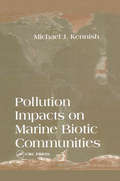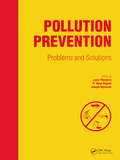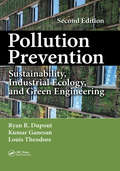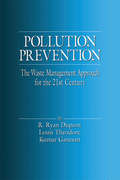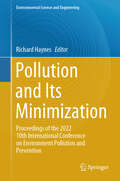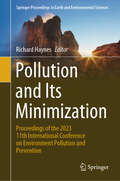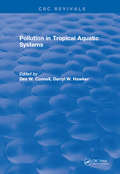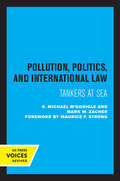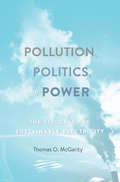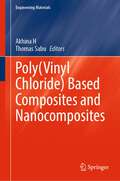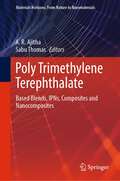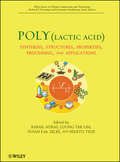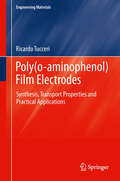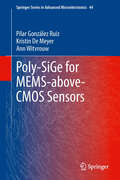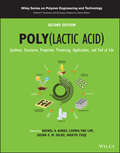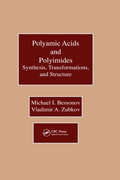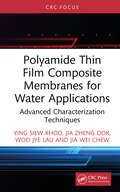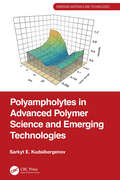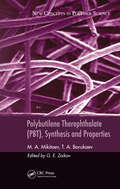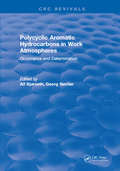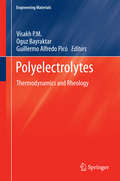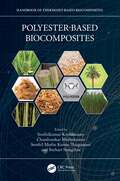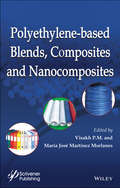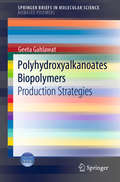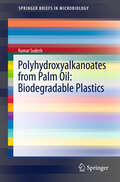- Table View
- List View
Pollution Impacts on Marine Biotic Communities (Crc Marine Science Ser. #14)
by Michael J. KennishPollution of estuaries and coastal marine waters is of profound ecological and societal importance. These coastal environments serve as critical habitat for a multitude of organisms and are of great commercial and recreational value to humans. Designed to meet the research, monitoring, and assessment needs of scientists, administrators, planners, and managers, Pollution Impacts on Marine Biotic Communities is a uniquely comprehensive reference covering pollution in coastal marine and estuarine waters. The book provides a detailed look at the short- and long-term impacts of pollutants on these ecologically important regions. Case studies that reflect a broad range of pollution problems are analyzed, outlining the real-life issues and providing solutions to common problems.Despite being highly sensitive systems, estuarine and coastal marine environments have served as repositories for dredge spoils, sewage sludge, and industrial and municipal effluents for many decades. The adverse effects of these pollutants are only now being fully realized and understood. Pollution Impacts on Marine Biotic Communities includes a basic introduction to the subject of pollution in estuarine and marine environments and also a detailed examination of specific marine pollutants. Both the coverage and the format - which includes abundant illustrations and tables - make this book a valuable reference for scientists, administrators, and students engaged in coastal research and planning.
Pollution Prevention
by Louis TheodoreEngineering and science professionals have studied the management of hazardous and toxic wastes extensively, and it is clear that the principal option of the future will be waste minimization, or pollution prevention. At present, however, few practicing professionals have a working understanding of this approach, educators are just starting to teach course material in this field, and students are only beginning to receive the training necessary to implement pollution prevention in their future work environment. An applications-oriented workbook of more than 100 exercises, Pollution Prevention: Problems and Solutions covers a variety of topics closely relevant to this field. The workbook is the result of a National Science Foundation College Faculty Workshop designed to generate new ideas and innovative educative approaches in the emerging, interdisciplinary field of pollution prevention. Contents include a pollution prevention overview in addition to problems and solutions organized into the categories of basic concepts, pollution prevention principles, regulations, source reduction, recycling, treatment, chemical plant/domestic applications, case studies, and ethics. Readership: Academics and students of undergraduate or graduate courses on waste management, as well as decision makers and practising professionals in the pollution prevention industry.
Pollution Prevention: Sustainability, Industrial Ecology, and Green Engineering, Second Edition
by Louis Theodore Kumar Ganesan Ryan DupontThis new edition has been revised throughout, and adds several sections, including: lean manufacturing and design for the environment, low impact development and green infrastructure, green science and engineering, and sustainability. It presents strategies to reduce waste from the source of materials development through to recycling, and examines the basic concepts of the physical, chemical, and biological properties of different pollutants. It includes case studies from several industries, such as pharmaceuticals, pesticides, metals, electronics, petrochemicals, refineries, and more. It also addresses the economic considerations for each pollution prevention approach.
Pollution Prevention: The Waste Management Approach to the 21st Century
by Louis Theodore R. Ryan Dupont Kumar GanesanApplying pollution prevention strategies - the most viable environmental management option of the future - offers a cost-effective means of minimizing waste. Pollution Prevention: The Waste Management Approach to the 21st Century provides the background needed to understand not only pollution prevention but also waste control. Thorough, clear, and concise, it explains the fundamentals of pollution prevention and their applications to real-world problems. It explores pollution prevention through energy conservation, health and safety management, and accident prevention. The authors include illustrative examples and case studies that demonstrate the solutions offered.
Pollution and Its Minimization: Proceedings of the 2022 10th International Conference on Environment Pollution and Prevention (Environmental Science and Engineering)
by Richard HaynesThis book presents peer-reviewed papers of the 2022 10th International Conference on Environment Pollution and Prevention (ICEPP 2022), which was held in Sydney, Australia, during December 16–18, 2022. With the worldwide increase in industrialization and movement of people toward larger cities, there has been a progressive increase in environmental pollution. The issues surrounding air, water, soil, and land pollution are now considered of global concern. Minimization of pollution involves the repeated reuse of products, reduction in waste generation, and processing and recycling of resources into new products. Pollution prevention practices not only reduce waste, but also improve safety and decrease disposal costs. The book is useful for students, academics, entrepreneurs, and professionals who are working in the important field of environmental pollution and its prevention.
Pollution and Its Minimization: Proceedings of the 2023 11th International Conference on Environment Pollution and Prevention (Springer Proceedings in Earth and Environmental Sciences)
by Richard HaynesThis book is a collection of selected, peer-reviewed papers presented at the 2023 11th International Conference on Environment Pollution and Prevention (ICEPP 2023), which was held in Brisbane, Australia, November 10–12, 2023. With the worldwide increase in industrialization and movement of people towards larger cities, there has been a progressive increase in pollution of the environment. The issues surrounding air, water, soil and land pollution are now considered of global concern. Minimization of pollution involves the repeated reuse of products, reduction in waste generation and processing and recycling of resources into new products. Pollution prevention practices not only reduce waste, but also improve safety and decrease disposal costs. The book is useful for students, academics, entrepreneurs and professionals who are working in the important field of pollution of the environment and its minimization and prevention.
Pollution in Tropical Aquatic Systems
by Des W. ConnellWe have identified a need to draw together knowledge of physiochemical and biological aspects of pollution in tropical aquatic systems. This book results from this and we hope will assist in providing management strategies to protect these systems from pollution effects. In organising the book we have, as far as possible, attempted to cover the range of topics important in understanding pollution in tropical areas. Authors who are expert in their particular fields have been invited to contribute. We recognise that many topics remain uncovered but we hope will serve to assist in identifying these and stimulate interest in this area.
Pollution, Politics, and International Law: Tankers at Sea
by R. Michael M’Gonigle Mark W. ZacherThis title is part of UC Press's Voices Revived program, which commemorates University of California Press’s mission to seek out and cultivate the brightest minds and give them voice, reach, and impact. Drawing on a backlist dating to 1893, Voices Revived makes high-quality, peer-reviewed scholarship accessible once again using print-on-demand technology. This title was originally published in 1979.
Pollution, Politics, and Power: The Struggle for Sustainable Electricity
by Thomas O. McGarityToday’s electric power companies compete to provide cleaner electricity. That’s a good thing, but progress has come with costs, especially for communities reliant on the coal industry. Thomas McGarity examines the changes of recent decades and offers ideas for building a more sustainable grid while easing the economic downsides of coal’s demise.
Poly (Engineering Materials)
by Akhina H Thomas SabuThis book covers Poly(vinyl chloride) Fundamentals, Fabrication and characterization of PVC based composites and nanocomposites specifically natural fibre reinforced PVC composites, carbonaceous filler reinforced PVC composites , metal oxide fled PVC composites and nanocomposites etc. This book also covers the conducting PVC composites and recent advances in nanocomposites based on PVC .The rheological, mechanical, barrier, thermal, dielectric behaviour of PVC composites and nanocomposites are discussed in details.
Poly Trimethylene Terephthalate: Based Blends, IPNs, Composites and Nanocomposites (Materials Horizons: From Nature to Nanomaterials)
by Sabu Thomas A. R. AjithaThis book explains general concepts of an important engineering thermoplastic polymer—polytrimethylene terephthalate (PTT). It describes preparation methods, characterization techniques, and various applications of PTT-based blends, IPNs, and composites. It also gives a clear idea about the engineering thermoplastic, PTT, and its importance in future. In addition to the basic concepts of PTT-based materials, the book also includes novel studies and issues on this topic. This book is an outcome of contributions by experts from different disciplines with various backgrounds and expertise. This book is useful for professionals, researchers, industrial practitioners, graduate students, and senior undergraduates of polymer science and engineering. Additionally, it is also beneficial for researchers working on materials science, surface science, bioengineering, chemical engineering, and nanomaterials. This book helps the researchers and students in expanding their knowledge in this field.
Poly(lactic acid)
by Rafael A. Auras Loong-Tak Lim Hideto Tsuji Susan E. SelkeThis book describes the synthesis, properties, and processing methods of poly(lactic acid) (PLA), an important family of degradable plastics. As the need for environmentally-friendly packaging materials increases, consumers and companies are in search for new materials that are largely produced from renewable resources, and are recyclable. To that end, an overall theme of the book is the biodegradability, recycling, and sustainability benefits of PLA. The chapters, from a base of international expert contributors, describe specific processing methods, spectroscopy techniques for PLA analysis, and and applications in medical items, packaging, and environmental use.
Poly(o-aminophenol) Film Electrodes
by Ricardo TucceriThis review book is concerned with the synthesis, charge transport properties and practical applications of poly (o-aminophenol) (POAP) film electrodes. It is divided into three parts. The first one has a particular emphasis on problems of synthesis and structure of POAP. The second part deals with the mechanism of charge transfer and charge transport processes occurring in the course of the redox reactions of POAP. The third part describes the promising applications of POAP in the different fields of sensors, electrocatalysis, bioelectrochemistry, corrosion protection, among others. This review covers the literature on POAP in the time period comprised between 1987 and 2013.
Poly-SiGe for MEMS-above-CMOS Sensors
by Kristin De Meyer Ann Witvrouw Pilar Gonzalez RuizPolycrystalline SiGe has emerged as a promising MEMS (Microelectromechanical Systems) structural material since it provides the desired mechanical properties at lower temperatures compared to poly-Si, allowing the direct post-processing on top of CMOS. This CMOS-MEMS monolithic integration can lead to more compact MEMS with improved performance. The potential of poly-SiGe for MEMS above-aluminum-backend CMOS integration has already been demonstrated. However, aggressive interconnect scaling has led to the replacement of the traditional aluminum metallization by copper (Cu) metallization, due to its lower resistivity and improved reliability. Poly-SiGe for MEMS-above-CMOS sensors demonstrates the compatibility of poly-SiGe with post-processing above the advanced CMOS technology nodes through the successful fabrication of an integrated poly-SiGe piezoresistive pressure sensor, directly fabricated above 0.13 m Cu-backend CMOS. Furthermore, this book presents the first detailed investigation on the influence of deposition conditions, germanium content and doping concentration on the electrical and piezoresistive properties of boron-doped poly-SiGe. The development of a CMOS-compatible process flow, with special attention to the sealing method, is also described. Piezoresistive pressure sensors with different areas and piezoresistor designs were fabricated and tested. Together with the piezoresistive pressure sensors, also functional capacitive pressure sensors were successfully fabricated on the same wafer, proving the versatility of poly-SiGe for MEMS sensor applications. Finally, a detailed analysis of the MEMS processing impact on the underlying CMOS circuit is also presented.
Poly: Synthesis, Structures, Properties, Processing, Applications, and End of Life (Wiley Series on Polymer Engineering and Technology #6)
by Rafael A. Auras Hideto Tsuji Susan E. M. Selke Loong-TakThe second edition of a key reference, fully updated to reflect new research and applications Poly(lactic acid) – PLA, biodegradable polymers derived from lactic acid, have become vital components of a sustainable society. Eco-friendly PLA polymers are used in numerous industrial applications ranging from packaging applications to medical implants and to wastewater treatment. The global PLA market is predicted to expand significantly over the next decade due to increasing demand for compostable and recyclable materials produced from renewable resources. Poly(lactic acid) Synthesis, Structures, Properties, Processing, Applications, and End of Life provides comprehensive coverage of the basic chemistry, production, and industrial use of PLA. Contributions from an international panel of experts review specific processing methods, characterization techniques, and various applications in biomedicine, textiles, packaging, and environmental engineering. Now in its second edition, this fully up-to-date volume features new and revised chapters on 3D printing, the mechanical and chemical recycling of PLA, PLA stereocomplex crystals, PLA composites, the environmental footprint of PLA, and more. Highlights the biodegradability, recycling, and sustainability benefits of PLA Describes processing and conversion technologies for PLA, such as injection molding, extrusion, blending, and thermoforming Covers various aspects of lactic acid/lactide monomers, including physicochemical properties and production Examines different condensation reactions and modification strategies for enhanced polymerization of PLA Discusses the thermal, rheological, and mechanical properties of PLA Addresses degradation and environmental issues of PLA, including photodegradation, radiolysis, hydrolytic degradation, biodegradation and life cycle assessment Poly(lactic acid) Synthesis, Structures, Properties, Processing, Applications, and End of Life, Second Edition remains essential reading for polymer engineers, materials scientists, polymer chemists, chemical engineers, industry professionals using PLA, and scientists and advanced students engineers interested in biodegradable plastics.
Polyamic Acids and Polyimides: Synthesis, Transformations, and Structure
by Michael I. Bessonov Vladimir A. ZubkovPolyamic Acids and Polyimides surveys significant developments in basic research in the chemistry and physics of polyamic acids and polyimides over the last several years. Traditional and new topics are discussed, including catalytical imidization, chemical reactions at thermal treatment, quantum-chemical study of synthesis and structure, properties of isolated molecules, and supermolecular and crystalline structures. The book will be an excellent reference for researchers, practitioners, and graduate students working with polyimides and related heat-resistant polymers and materials.
Polyamide Thin Film Composite Membranes for Water Applications: Advanced Characterization Techniques
by Woei Jye Lau Ying Siew Khoo Jia Zheng Oor Jia Wei ChewThe global market for polymeric membranes used in water and wastewater treatment is experiencing robust growth, with polyamide (PA) thin film composite (TFC) membranes dominating reverse osmosis (RO) and nanofiltration (NF) processes. This monograph presents the latest trends in characterization techniques for PA TFC membranes and provides the most current and relevant information on these techniques tailored specifically for TFC NF and RO membranes.Features• Focuses solely on the characterization of PA TFC membranes used in water and wastewater treatment.• Provides the latest insights into employing advanced and emerging characterization tools to analyze the intrinsic properties of the PA selective layer and evaluate the overall performance of PA TFC membranes during filtration processes.• Extensively examines the strengths and limitations of each membrane characterization tool, offering in-depth analyses for readers.This book is an indispensable reference and practical guide for advanced students, researchers, and scientists involved in NF and RO membrane fabrication and characterization, including those in the fields of chemical, materials, and environmental engineering.
Polyampholytes in Advanced Polymer Science and Emerging Technologies (Emerging Materials and Technologies)
by Sarkyt E. KudaibergenovPolyampholytes are unique polymers containing acid/base and/or anionic/cationic groups in the main or side chains. Water-soluble and water-swelling polyampholytes exhibit properties that provide broad potential as structural biomaterials, drug delivery and chemo-mechanical systems, biosensors, energy storage devices, supercapacitors, and actuators, among others. This monograph reviews the innovative studies in this field over the past two decades, with the aim to analyze and systematize the literature in the context of emerging technologies. Offers a multidisciplinary perspective covering polyampholytes, polybetaines, and polyzwitterions in nanotechnology, biotechnology, medicine, catalysis, environment protection, and oil industry applications Demonstrates a wide range of applications for these materials with enough depth to provide critical fundamental knowledge for new researchers in the field Discusses polyampholyte-protected and gel-immobilized metal nanoparticles and enzymes that catalyze reactions of hydrolysis, decomposition, hydrogenation, and oxidation of various substrates in batch-type and continuous flow–type reactors Highlights the remaining persistent challenges in the development and application of these materials This book will appeal to readers who conduct materials research for biomedical, water treatment, and environmental remediation applications.
Polybutilene Therephthalate (PBT), Synthesis and Properties
by M.A. Mikitaev T.A. BorukaevThis volume gives an analysis of recent achievements in the field of synthesis, structural investigations, and properties of polybutilene therephthalate (PBT). Furthermore, the mechanism of PBT synthesis by equilibrium polycondensation reaction is described together with the used reagents, catalysts, and stabilizers.
Polycyclic Aromatic Hydrocarbons in Work Atmospheres: Occurrence and Determination
by Alf BjorsethThis book deals with the sources, distribution, analytical methods, and monitoring of Polycyclic aromatic hydrocarbons (PAH) in the occupational environment. It is hoped that this book will make a contribution to understanding the formation and determination of PAH in work atmosphere and that it will make a particular contribution to occupational health projects. Much of the information given in this book has been generating in studies carried out in cooperation with the Norwegian aluminium industry.
Polyelectrolytes
by Visakh P. M. Oguz Bayraktar Guillermo Alfredo PicóThis book offers a valuable reference source to graduate and post graduate students, engineering students, research scholars polymer engineers from industry. The book provides the reader with current developments of theoretical models describing the thermodynamics polyelectrolytes as well as experimental findings. A particular emphasis is put on the rheological description of polyelectrolyte solutions and hydrogels.
Polyester-Based Biocomposites
by Suchart Siengchin Senthilkumar Krishnasamy Chandrasekar Muthukumar Senthil Muthu Kumar ThiagamaniPolyester-Based Biocomposites highlights the performance of polyester-based biocomposites reinforced with various natural fibres extracted from leaf, stem, fruit bunch, grass and wood material. It also addresses the characteristics of polyester-based biocomposites reinforced with rice husk fillers and various nanoparticles. This book explores the widespread applications of fibre-reinforced polymer composites in the aerospace sector, automotive parts, construction and building materials, sports equipment and household appliances. Investigating the advantages of natural fibres, such as superior damping characteristics, low density, biodegradability, abundant availability at low cost and non-abrasive to tooling, this book discusses what makes them a cost-effective alternative reinforcement material for composites in certain applications. This book serves as a useful reference for researchers, graduate students and engineers in the field of polymer composites.
Polyethylene-Based Blends, Composites and Nanocomposities
by Visakh P. M. María José MorlanesThe book focusses on the recent technical research accomplishments in the area of polyethylene-based blends, composites and nanocomposites by looking at the various aspects of processing, morphology, properties and applications. <P><P> In particular, the book details the important developments in areas such as the structure-properties relationship of polyethylene; modification of polyethylene with radiation and ion implantation processes; stabilization of irradiated polyethylene by the introduction of antioxidants; reinforcement of polyethylene through carbon-based materials as additives; characterization of carbon-based polyethylenes composites, polyethylene-based blends with thermoplastic and thermoset; characterization of polyethylene-based thermoplastic and thermoset blends; polyethylene-based blends with natural rubber and synthetic rubber; characterization of polyethylene-based natural rubber and synthetic rubber blends; characterization of polyethylene-based composites.
Polyhydroxyalkanoates Biopolymers: Production Strategies (SpringerBriefs in Molecular Science)
by Geeta GahlawatThis book focuses on both production and extraction aspects of Polyhydroxyalkanoates (PHAs) for their commercialization purpose. PHAs have broad range of applications in packaging, food, agriculture and pharmaceutical industries. Until now literature reports have discussed either production strategies or extraction protocols. But for commercialization purpose both issues need to be addressed. This book highlights other copolymers of PHAs which have much better physico-mechanical properties such as elasticity and strength than polyhydroxybutyrate (PHB). Finally efficient product recovery protocols and process optimization strategies including renewable substrates, high cell density cultivations, genetic engineering and mathematical modeling are discussed in detail in order to outline the progress made so far in the area of economic biopolymer production. The primary audience will be scholars, researchers and professors working in colleges, universities, research institutes and government organizations.
Polyhydroxyalkanoates from Palm Oil: Biodegradable Plastics
by Kumar SudeshThe environmental problems caused by petroleum-based plastic and plastic waste have led to an increasing demand for biobased and biodegradable plastics, such as polyhydroxyalkanoates (PHAs). These polyesters are synthesized from carbon sources, e.g. sugar and plant oils, by various bacteria. This book highlights the potential of plant oils, especially palm oil, as a feedstock for PHA production. In addition, new PHA applications are discussed and the sustainability of PHA production from plant oils is critically examined.
